Problem-Oriented Modelling for Biomedical Engineering Systems
Abstract
:1. Introduction
- Their development is based on a functional approach, in which each structural element of the system is chiefly treated as a carrier or an object with a certain function (action).
- Every function is defined in terms of its carrier (which creates the action), its object (to which the carrier’s action is directed), the action itself, and the conditions of the action’s realization.
- In general, the system structure is represented by a function tree (tree function graph—TFG), the branches of which are actions, and the nodes being their carriers and objects.
- Functions, the realisation of which does not provide the required quality parameters of the system, are called problem functions.
- It is assumed that the imperfection and interrelation of individual interactions within the TFG results in conflicting requirements for particular TFG branches and nodes, the assuring of which needs either the finding of the optimal trade-off between certain parameters or a reconfiguration of the graph.
- Functions, the realisation of which should meet contradictory demands to system parameters, elements, or their interactions, are called conflicting, and the conflicts (contradictions) of demands themselves are considered to be the main source of improvement and development of TS when exhausting the optimization potential.
- TS and task models are built considering the significance of these conflicts. Since the purpose of modelling is directly related to the identification and solving of conflict problems or situations, it is appropriate to classify models with the above features into a separate category of problem-oriented models (Table 1).
- Introducing additional elements into the model for expanding the field of search.
- Eefining the axiomatics of the model, i.e., the essential elements and the relationships between them and their representations, in order to clarify the search directions.
- Aggregation of different types of models in order to combine their advantages.
- Combination of models and problem-solving tools.
2. Background
2.1. Substance-Field Model (SF)
2.2. Physical Contradiction (PhC)
2.3. Function Model (FM) and Functional Analysis Diagram (FA)
2.4. ‘Nested’ Function Model and Extended ‘Nested’ Function Model
2.5. Causal Loop Diagram (CLD)
2.6. Tool-Object-Product Model (TOP Model)
2.7. Triad Models
3. Proposed Expanded Triad Model
- The enabling element Sen can participate in the following pairs of interactions: ‘useful functions Fen1 and Fen2′; ‘useful function Fen1 and accompanying undesirable function Fnd1, which may be generated when attempting to improve Fen1′; ‘useful function Fen2 and accompanying undesirable function Fnd2, which may be generated when improving Fen1 via the enabling element.’
- The active element Sa can participate in the following pairs of interactions: ‘useful function Fen2 (for which the active element is a product) and useful function Fa (for which the active element is a tool)’, ‘useful function Fa and accompanying undesirable function Fnd3, which may be generated when attempting to improve Fa’; ‘useful function Fen2 and accompanying undesirable function Fnd4, which may be generated when attempting to improve Fen2 by changing the active element.’
- The passive element S0 can participate in the following pairs of interactions: ‘useful functions Fen1 and Fen2 (when considering the passive element as the problem one)’; ‘useful function Fa and accompanying undesirable function Fnd5, which may originate when attempting to improve Fa by affecting the passive element’; ‘useful function Fen1 and accompanying undesirable function Fnd6, which may originate when attempting to improve Fa by affecting the passive element’.
4. Application of the Model to Inventive Problem Solving in the Case of Defibrillator Improvement
- By a systemic transition at the stage of the previous key problems [28]—changing the pulse shape requirements in such a way that a lower energy pulse would achieve the same defibrillation effect (transition to bipolar pulses of complex shape with an increased electrotherapeutic index—ratio of damaging and defibrillating thresholds).
- By separating the conflicting requirements PhC0, PhC3 in time or space by sequential emission of multiple pulses (in time, US Patent 6 405 084 [46]) and/or simultaneously (multiple implantable electrodes at different parts of the heart, US Patent 6038472 [47]), each with the desired profile but a smaller amplitude, so that the total energy delivered equals the energy required for effective defibrillation (solution implemented in US Patents 5531768 [48], 5531764 [49]).
- By separating conflicting requirements PhC0, PhC3 in time by “overshooting” [27,28,32], i.e., by speeding up the most dangerous parts of the process. US patent 6029085 [50] proposes a defibrillator circuit design with accelerated capacitor charging, which stabilises the defibrillation threshold and increases patient safety.
- By separating conflicting requirements PhC5 over time with increase of the efficiency of the inefficient subfield “Sa-Fa-S0” by changing the absorption capacity of the heart (increasing the energy that is transferred to the heart is achieved by changing the parameters of the heart. US Patent 6363276 [51] provides a device consisting of a pump capable of pumping blood and a flow rate meter. The device can pump some of the blood out of the ventricle, resulting in ventricle volume decrease and a larger portion of the defibrillation pulse energy absorbed into the appropriate parts of the heart);
- By separating conflicting requirements PhC0, PhC3 over time with destruction of a harmful SF “Sa-Fa2-S0” with excessive energy impact by absorbing excess discharge energy from storage capacitors (US patent 6212429 [52], according to which additional pulses of opposite polarity are emitted to suppress the excess energy impact).
- By a systemic transition (fragmentation and transition to the micro level providing opposite properties to the system and its parts) with obtaining the required pulse profile in a ‘pulsating mode’ due to the emission of a sequence of extremely short and rapidly subsequent rectangular pulses of varying amplitude and polarity, the envelope of which sets the desired pulse shape and energy (US Patent 6173274 [53]).
- By separating conflicting requirements PhC0, PhC2, PhC3 in time in combination with systemic transition by using a biphasic pulse delivery circuit with two capacitors, each delivering different phases of the biphasic pulse, where at least a portion of the charge on the second capacitor is provided by the current flow through the patient during delivery of the first pulse phase (US Patent 8145300 [54]).
- By separating conflicting requirements PhC0, PhC3 in space with increasing the efficiency of the SF “Sa-Fa-S0” (state A) by using plurality of electrodes emitting pulses with a smaller amplitude so that the total energy delivered equals the energy required for effective defibrillation (US Patent 7920917 [55]).
- By separating conflicting requirements PhC0, PhC3, PhC5, PhC6 in time with increasing the efficiency of the SF “Sa-Fa-S0” (state A) due to generating by switching capacitance configuration a special ascending biphasic waveform with at least two peaks of different amplitudes: the amplitude of the second peak is greater than the amplitude of the first peak. The heart is activated during the first phase thereby enhancing the effect of the second pulse peak current (US Patent 8965501 [56]).
- By separating conflicting requirements PhC0, PhC3, PhC5, PhC6 in time with increasing the efficiency of the SF “Sa-Fa-S0” (state A) due to applying a defibrillation circuit emitting a pre-pulse before the defibrillation pulse, not as intense as the defibrillation pulse, but still intense enough to induce mechanical contraction of muscles in parts of the thorax and possibly the heart. The heart’s electrical conductivity is changed, thereby enhancing the effect of the subsequent defibrillation pulse of energy lower than usual (European Patent Application EP0588124A1 [57]).
- By destroying the harmful SF “Sa-Fa2-S0” (state B) by introducing a current limiter for a defibrillation pulse, which is powered by the defibrillation pulse, and switches the current delivery path open and closed when an excessive current condition exists (current achieves values over predetermined “safe” level) (US Patent 9415230B2 [58]).
- By increasing the efficiency of the SF “Sa-Fa2-S0” (state A) due to a dynamically adjustable multiphasic defibrillator pulse system containing several high-energy reservoirs and/or sources that together can be utilized to provide the various multiphasic waveforms, managed by the control logic and heart rhythm sense component, thus ensuring that it is as optimal as possible for the individual patient. Each control logic in each subsystem may have a circuit that can be used to adjust the shape of each portion of the therapeutic pulse (US Patent 9855440B2 [59]).
- By preventing the appearance of the harmful SF “Sa-Fa2-S0” (state B) by introducing planar electrode made of tin bonded to a flash-spun high-density polyethylene fibrous matrix with an increased surface area and without areas vulnerable to crushing of the dielectric layer under button electrodes. This electrode design results in local current density that is sufficiently low to avoid thermal injury (US Patent 5330526A [60]).
- By preventing the appearance of the harmful SF “Sa-Fa2-S0” (state B) due to the soothing the current distribution with the electrode presented by a plurality of concentric conductive rings electrically connected together with the interface impedance of the inner conductive segments lower than that of the outer conductive segments (US Patent 5271417 [61]).
- By destroying the harmful SF “Sa-Fa2-S0” (state B) due to the incorporating a current redistribution layer composed of a polymeric sheet of dielectric material between the button electrodes and the patient-facing surface to homogenize the local current densities under the entire electrode ([62]).
- By separating conflicting requirements via systemic transition for preventing the appearance of the harmful SF “Sa-Fa2-S0” (state B) by adding a reusable component having a flexible nonconductive element and a flexible metallic element comprising a plurality of substantially inflexible metallic elements interconnected by flexible metallic linking elements to a hands-free defibrillation electrode. The flexible metallic element has an exposed surface on one side of the reusable component and the exposed surface and is configured to accept an electrical defibrillation pulse and spread the electrical pulse across the exposed surface area, from which it is delivered to the patient’s chest (China Patent CN102458562A [63]).
5. Conclusions
Author Contributions
Funding
Institutional Review Board Statement
Informed Consent Statement
Data Availability Statement
Conflicts of Interest
References
- Keshwani, S.; Lenau, T.A.; Ahmed-Kristensen, S.; Chakrabarti, A. Comparing Novelty of Designs from Biological-Inspiration with Those from Brainstorming. J. Eng. Des. 2017, 28, 654–680. [Google Scholar] [CrossRef] [Green Version]
- Lawnik, M.; Banasik, A. Delphi Method Supported by Forecasting Software. Information 2020, 11, 65. [Google Scholar] [CrossRef] [Green Version]
- Johansen, I. Scenario Modelling with Morphological Analysis. Technol. Forecast. Soc. Chang. 2018, 126, 116–125. [Google Scholar] [CrossRef]
- Serikbayeva, A.; Beisenbayeva, L. Synectics as a Modern Method of Solving Creative Problems. In Paradigm Shifts in 21st Century Teaching and Learning; IGI Global: Hershey, PA, USA, 2020; pp. 145–157. [Google Scholar] [CrossRef]
- Sicoe, G.M.; Belu, N.; Rachieru, N.; Nicolae, E.V. Improvement of the Customer Satisfaction through Quality Assurance Matrix and QC-Story Methods: A Case Study from Automotive Industry. IOP Conf. Ser. Mater. Sci. Eng. 2017, 252, 12045. [Google Scholar] [CrossRef]
- Divanoğlu, S.U.; Taş, Ü. Application of 8D Methodology: An Approach to Reduce Failures in Automotive Industry. Eng. Fail. Anal. 2022, 134, 106019. [Google Scholar] [CrossRef]
- Ekmekci, I.; Nebati, E.E. Triz Methodology and Applications. Procedia Comput. Sci. 2019, 158, 303–315. [Google Scholar] [CrossRef]
- Sojka, V.; Lepšík, P. Use of Triz, and Triz with Other Tools for Process Improvement: A Literature Review. Emerg. Sci. J. 2020, 4, 319–335. [Google Scholar] [CrossRef]
- Lin, Y.S.; Chen, M. Implementing TRIZ with Supply Chain Management in New Product Development for Small and Medium Enterprises. Processes 2021, 9, 614. [Google Scholar] [CrossRef]
- Feniser, C.; Burz, G.; Mocan, M.; Ivascu, L.; Gherhes, V.; Otel, C.C. The Evaluation and Application of the TRIZ Method for Increasing Eco-Innovative Levels in SMEs. Sustainability 2017, 9, 1125. [Google Scholar] [CrossRef] [Green Version]
- Chang, D.S.; Wu, W. De Impact of the COVID-19 Pandemic on the Tourism Industry: Applying TRIZ and DEMATEL to Construct a Decision-Making Model. Sustainability 2021, 13, 7610. [Google Scholar] [CrossRef]
- Zhang, P.; Li, X.; Nie, Z.; Yu, F.; Liu, W. A Trimming Design Method Based on Bio-inspired Design for System Innovation. Appl. Sci. 2021, 11, 4060. [Google Scholar] [CrossRef]
- Boavida, R.; Navas, H.; Godina, R.; Carvalho, H.; Hasegawa, H. A Combined Use of TRIZ Methodology and Eco-Compass Tool as a Sustainable Innovation Model. Appl. Sci. 2020, 10, 3535. [Google Scholar] [CrossRef]
- Kalenik, M.; Chalecki, M. Model Investigations of Flow Rate and Efficiency of Air Lift Pump with Pm 50 Mixer and Circumferential Mixer. Rocz. Ochr. Sr. 2020, 22, 456–474. [Google Scholar]
- Trach, Y.; Trach, R.; Kalenik, M.; Koda, E.; Podlasek, A. A Study of Dispersed, Thermally Activated Limestone from Ukraine for the Safe Liming Ofwater Using Ann Models. Energies 2021, 14, 8377. [Google Scholar] [CrossRef]
- Witkowska-Dobrev, J.; Szlachetka, O.; Dohojda, M.; Wiśniewski, K. Effect of Acetic Acid on Compressive Strength and Geometric Texture of the Surface of C20/25 Class Concrete. Sustainability 2021, 13, 5136. [Google Scholar] [CrossRef]
- Szlachetka, O.; Witkowska-Dobrev, J.; Baryła, A.; Dohojda, M. Low-Density Polyethylene (LDPE) Building Films—Tensile Properties and Surface Morphology. J. Build. Eng. 2021, 44, 103386. [Google Scholar] [CrossRef]
- Tan, J.W. Conceptual Design of the Crutches Using TRIZ-Biomimetics Method; Project Report; UteM: Melaka, Malaysia, 2020. [Google Scholar]
- Ramírez-Rios, L.Y.; Camargo-Wilson, C.; Olguín-Tiznado, J.E.; López-Barreras, J.A.; Inzunza-González, E.; García-Alcaraz, J.L. Design of a Modular Plantar Orthosis System through the Application of TRIZ Methodology Tools. Appl. Sci. 2021, 11, 2051. [Google Scholar] [CrossRef]
- Molavi-Taleghani, Y.; Ebrahimpour, H.; Sheikhbardsiri, H. A Proactive Risk Assessment through Healthcare Failure Mode and Effect Analysis in Pediatric Surgery Department. J. Compr. Pediatr. 2020, 11, 56008. [Google Scholar] [CrossRef]
- de la Tejera-de la Pena, J.A. Development and Implementation of a Categorization Model for the Exoskeletons Based on Their Design Characteristics and Practical Projects. Master’s Thesis, School of Computer Science and Engineering, Ciudad de México, Mexico, 2020. [Google Scholar]
- Bertoncelli, T.; Gronauer, B.; Nähler, H. TRIZ Barcamp Exercise: Ideas for Wearable Defibrillators. In New Opportunities for Innovation Breakthroughs for Developing Countries and Emerging Economies; Benmoussa, R., De Guio, R., Dubois, S., Koziołek, S., Eds.; Springer Nature Switzerland AG: Cham, Switzerland, 2019; pp. 257–265. ISBN 9783030324964. [Google Scholar]
- Guner, S.; Kose, I. Creative Problem Solving Technique Application Areas of TRIZ: Suggestions for Use in Healthcare Sector. J. Econ. Bus. Financ. Res. 2020, 2, 185–208. [Google Scholar] [CrossRef]
- Kose, I.; Guner, S. A New Approach That Proposes TRIZ as a Creative Problem Solving Technique in Health Services. Pressacademia 2020, 7, 67–79. [Google Scholar] [CrossRef]
- Degland, A.; Jean, C.; Gazo, C. Using TRIZ in the Healthcare Environment: First Proposition of a New Design Method. In New Opportunities for Innovation Breakthroughs for Developing Countries and Emerging Economies; Benmoussa, R., De Guio, R., Dubois, S., Koziołek, S., Eds.; Springer Nature Switzerland AG: Cham, Switzerland, 2019. [Google Scholar]
- Altshuller, G.S. 40 Principles: TRIZ Keys to Technical Innovation. Translated by Lev Shulyak; Technical Innovation Center: Worcester, MA, USA, 1998. [Google Scholar]
- Altshuller, G.S. Tvorchestvo Kak Tochnaya Nauka [Creativity as an Exact Science], 2nd ed.; Publishing House Scandinavia: Petrozavodsk, Russia, 2004. (In Russian) [Google Scholar]
- Altshuller, G.S. Nayti Ideyu. Vvedenie v TRIZ—Teoriyu Resheniya Izobretatelskih Zadach [Find an Idea. Introduction to TRIZ—The Theory of Inventive Problem Solving]; Alpina Publisher: Moscow, Russia, 2021. (In Russian) [Google Scholar]
- Russo, D.; Duci, S. From Altshuller’s 76 Standard Solutions to a New Set of 111 Standards. Procedia Eng. 2015, 131, 747–756. [Google Scholar] [CrossRef] [Green Version]
- Nähler, H.T.; Gronauer, B. Using Enhanced Nested Function Models for Strategic Product Development. In Research and Practice on the Theory of Inventive Problem Solving (TRIZ): Linking Creativity, Engineering and Innovation; Chechurin, L., Ed.; Springer: Cham, Switzerland, 2016; pp. 55–75. ISBN 9783319317823. [Google Scholar]
- Souchkov, V. A Glossary of Essential TRIZ Terms. In Research and Practice on the Theory of Inventive Problem Solving (TRIZ): Linking Creativity, Engineering and Innovation; Chechurin, L., Ed.; Springer: Cham, Switzerland, 2016; pp. 1–281. ISBN 9783319317823. [Google Scholar]
- Delgado-Maciel, J.; Cortés-Robles, G.; Alor-Hernández, G.; Alcaráz, J.G.; Negny, S. A Comparison between the Functional Analysis and the Causal-Loop Diagram to Model Inventive Problems. Procedia CIRP 2018, 70, 259–264. [Google Scholar] [CrossRef]
- Royzen, Z. Tool, Object, Product (TOP) Function Analysis. TRIZ J. 1999, 9. Available online: https://metodolog.ru/triz-journal/archives/1999/09/d/index.htm (accessed on 15 March 2021).
- Royzen, Z. Solving Problems Using TOP-TRIZ. Available online: http://120.55.91.217/wp-content/uploads/soft/100915/SolvingProblemsUsingTOP-TRIZ.pdf (accessed on 15 March 2021).
- Kowalick, J. Triads: Their Relationship with TRIZ—Elaboration on the Use of Triads and TRIZ to Solve Impossible Problems and Create Next-Generation, Breakthrough Designs. TRIZ J. 1998, 6. Available online: https://metodolog.ru/triz-journal/archives/1998/06/a/index.htm (accessed on 15 March 2021).
- Mueller, G. Accurately and Rapidly Predicting Next-Generation Product Breakthroughs in the Medical-Devices, Disposable Shaving Systems, and Cosmetics Industries. TRIZ J. 1999, 3. Available online: https://metodolog.ru/triz-journal/archives/1999/03/c/index.htm (accessed on 12 June 2021).
- Bukhman, I. Technology for Innovation. How to Create New Systems, Develop Existing Systems and Solve Related Problems; Springer: Singapore, 2021; ISBN 9789811610400. [Google Scholar]
- Terninko, J.; Domb, E.; Miller, J. The Seventy-Six Standard Solutions, with Examples Section One. TRIZ J. 2000, 26, 7–8. [Google Scholar]
- Chybowski, L. Use of Triz SU-Field Models in the Process of Improving the Injector of an Internal Combustion Engine. Multidiscip. Asp. Prod. Eng. 2018, 1, 257–268. [Google Scholar] [CrossRef] [Green Version]
- Chen, L.-S.; Chen, S.-H. Using TRIZ Techniques to New Product Function Development of Smart Phones. Ind. Eng. Manag. Syst. 2011, 10, 179–184. [Google Scholar] [CrossRef] [Green Version]
- Terninko, J. Su-Field Analysis. TRIZ J. 2000, 2. Available online: https://metodolog.ru/triz-journal/archives/2000/02/d/article4_02-2000.html (accessed on 12 December 2021).
- Domb, E.; Terninko, J.; Miller, J.; MacGran, E. The Seventy-Six Standard Solutions: How They Relate to the 40 Principles of Inventive Problem Solving. TRIZ J. 1999, 5. Available online: https://metodolog.ru/triz-journal/archives/1999/05/e/index.htm (accessed on 12 June 2021).
- Carver, J.W. Dry Marker and Eraser System. U.S. Patent 6,048,121, 11 April 2000. [Google Scholar]
- Hlinenko, L. Biosystemotekhnichnyi Pidzhkhid Do «triadnoho Modeliuvannia». In Matematychne Modeliuvannia ta Kompiuterni Tekhnolohii Bio-System Engineering Approach to “Triad” Modelling; Visnyk NU «Lvivska Politekhnika»: Lviv, Ukraina, 2003; pp. 180–185. [Google Scholar]
- Frenklach, G. Efficient Use of the System Operator. TRIZ J. 1998, 1. [Google Scholar]
- Plicchi, G.; Garberoglio, B.; Gaggini, G.; Marcelli, E. Implantable Atrial Defibrillator Apparatus. U.S. Patent 6,405,084, 11 June 2002. [Google Scholar]
- Williams, T.M.; Mulier, P.M.; Keimel, J.G.; Laske, T.G.; Boser, G.A.; Morris, M.M.; Min, X. Implantable Defibrillator and Lead System. U.S. Patent 6,038,472, 14 March 2000. [Google Scholar]
- Alferness, C.A. Implantable Atrial Defibrillator Having Ischemia Coordinated Intervention Therapy and Method. U.S. Patent 5,531,768, 2 July 1996. [Google Scholar]
- Adams, T.P.; Kroll, M.W. Implantable Defibrillator System and Method Having Successive Changeable Defibrillation. U.S. Patent 5,531,764, 22 February 1996. [Google Scholar]
- Olson, K.F.; Gilman, B.L. Charging and Safety Control for Automated External Defibrillator and Method. U.S. Patent 6,029,085, 2 July 2000. [Google Scholar]
- Prem, E.K.; Kolenik, S.A. Magnetically Suspended Fluid Pump and Control System with Defibrillator. U.S. Patent 6363276B1, 26 March 2002. [Google Scholar]
- Sullivan, J.L.; Borschowa, L.A.; Nova, R.C. Method and Apparatus for Converting a Monophasic Defibrillator to a Biphasic Defibrillator. U.S. Patent 6,487,448, 26 November 2002. [Google Scholar]
- Ryan, F.W.J. Production Mail System Having Subsidies for Printing of Third Party Messages on Mailpieces. U.S. Patent 6,173,274, 9 January 2001. [Google Scholar]
- Powers, D.J. Simplified Biphasic Defibrillator Circuit with Make-Only Switching. U.S. Patent 8,145,300, 27 March 2012. [Google Scholar]
- Kelly, P.F.; Kavounas, G.T.; Sullivan, J.L. External Defibrillator and Methods for Operating Theexternal Defibrillator. U.S. Patent 20110166615, 7 July 2011. [Google Scholar]
- Sullivan, J.L. Sequential Stacked Capacitor Defibrillator and Waveform Generated Therefrom. U.S. Patent 8,965,501, 24 February 2015. [Google Scholar]
- Hedberg, S.-E. Heart Defibrillator. European Patent EP0588124A1, 20 January 1999. [Google Scholar]
- Powers, D. Energy Efficient Defibrillation Current Limiter. U.S. Patent 9,415,230, 16 August 2016. [Google Scholar]
- Raymond, D.M.; Gray, P.D.; Savage, W.T.; Savage, S.J. Dynamically Adjustable Multiphasic Defibrillator Pulse System and Method. U.S. Patent 9,616,243, 10 April 2017. [Google Scholar]
- Fincke, R.W.; Stutz, R.S. Combined Defibrillation and Pacing Electrode. U.S. Patent 5,330,526, 19 July 1994. [Google Scholar]
- Swanson, D.K.; Dahl, R.W.; Lang, D.J. Defibrillation Electrode Having Smooth Current Distribution. U.S. Patent 5,271,417, 21 December 1993. [Google Scholar]
- Singleton, M.J.; Schoenfeld, M.H.; Bhave, P.D.; Beaty, E.H.; Whalen, S.P. Third-Degree Burns Caused by Transcutaneous Pacing for Third-Degree Heart Block. HeartRhythm Case Rep. 2020, 6, 495–498. [Google Scholar] [CrossRef] [PubMed]
- Pisit, K.; Dupelle, M.R. Defibrillation Electrodes. China Patent CN102458562A, 15 August 2017. [Google Scholar]
- Kernytskyy, I.; Yakovenko, Y.; Storchun, Y.; Horbay, O.; Humenyuk, R.; Sholudko, Y. Modelling of artery stiff ness for driver’s heart rate monitoring systems development. Acta Sci. Pol. Archit. 2020, 19, 15–20. [Google Scholar] [CrossRef]

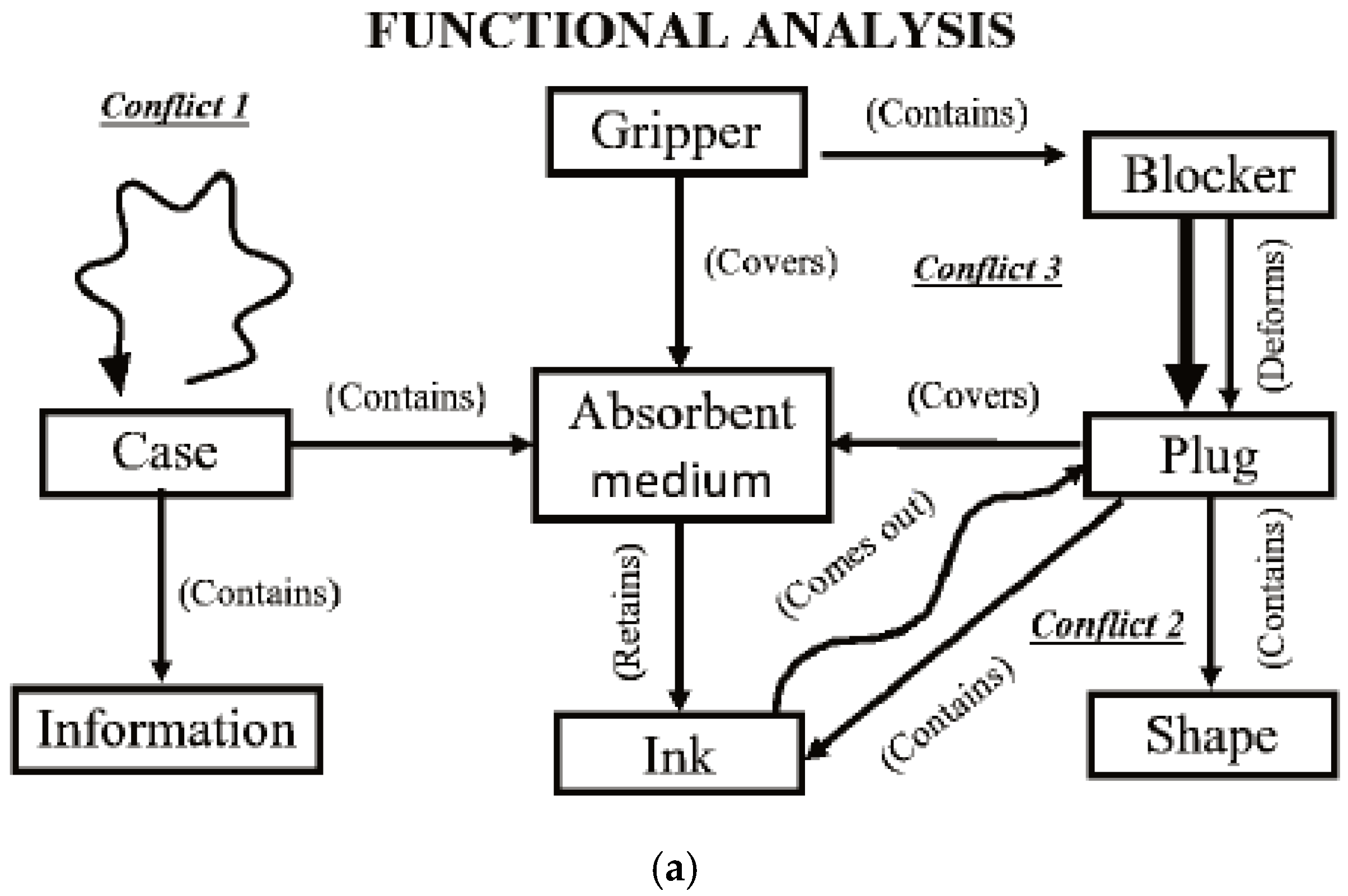
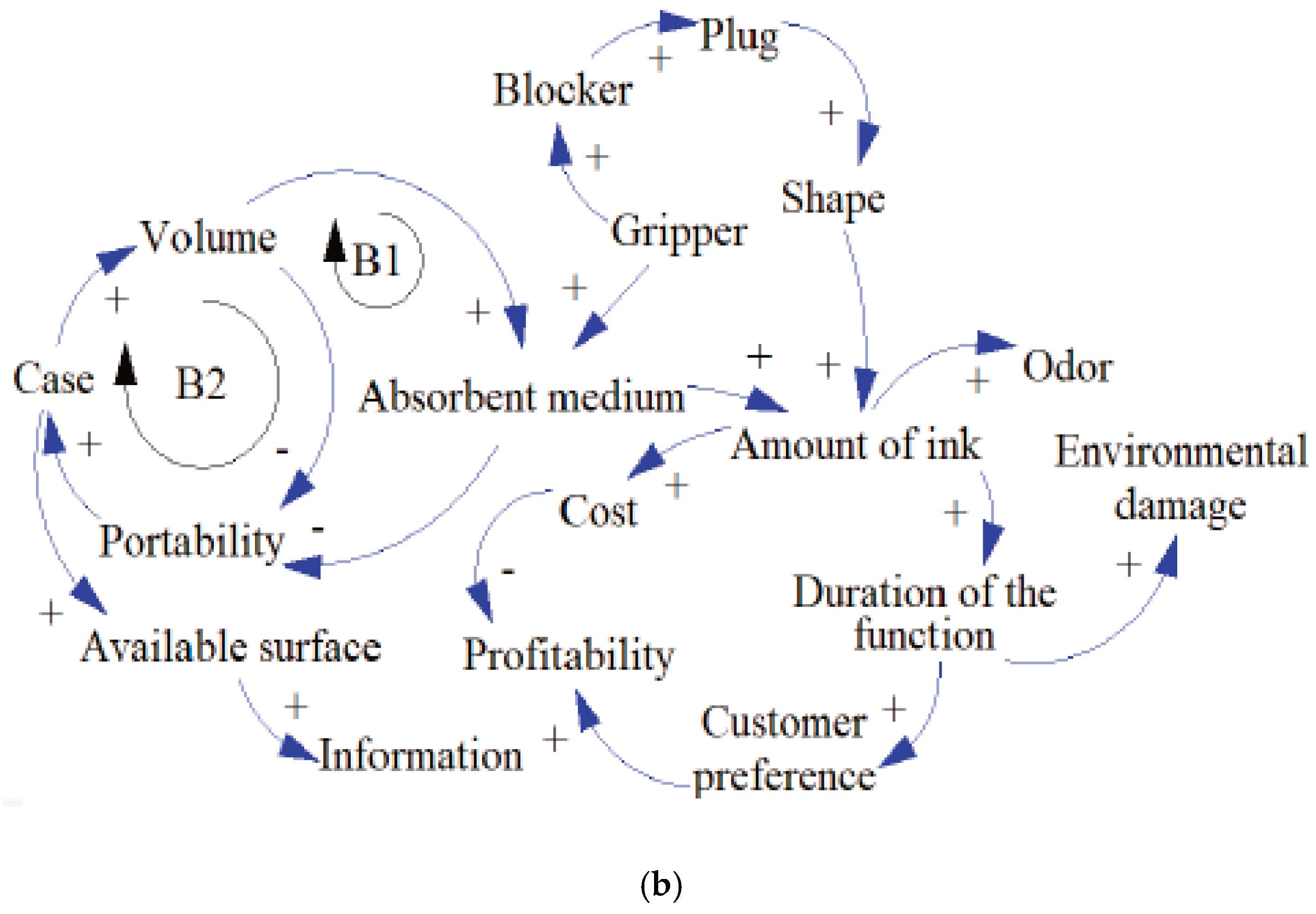

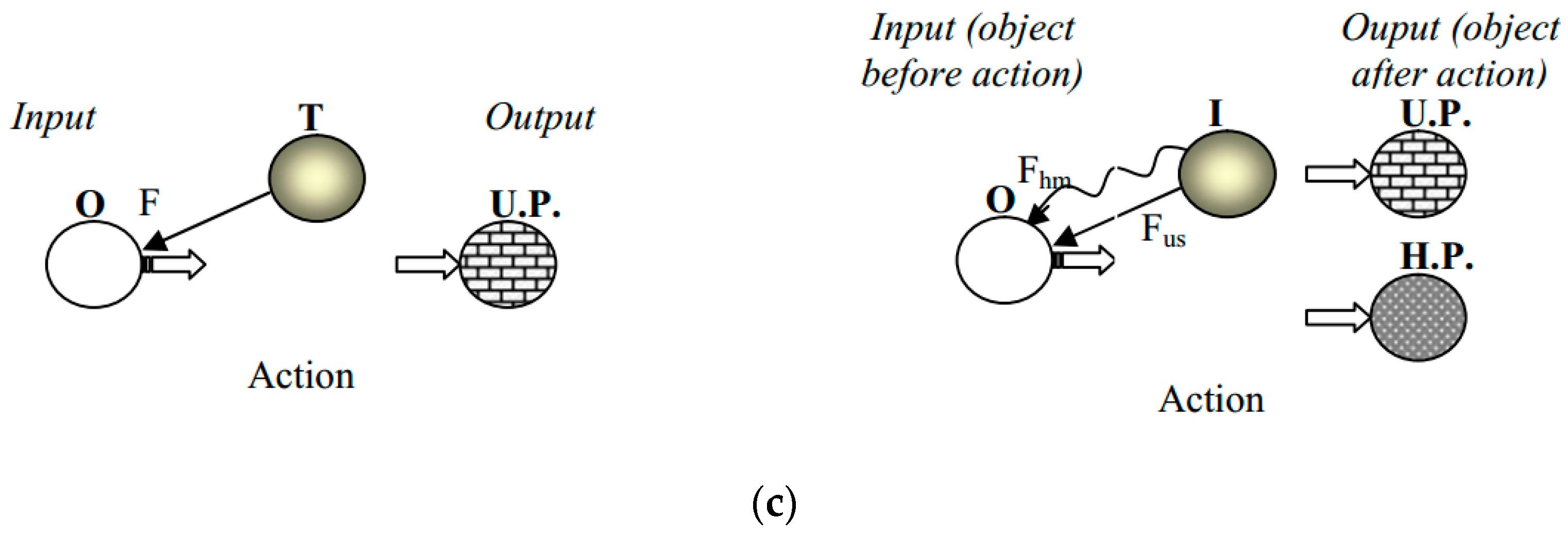

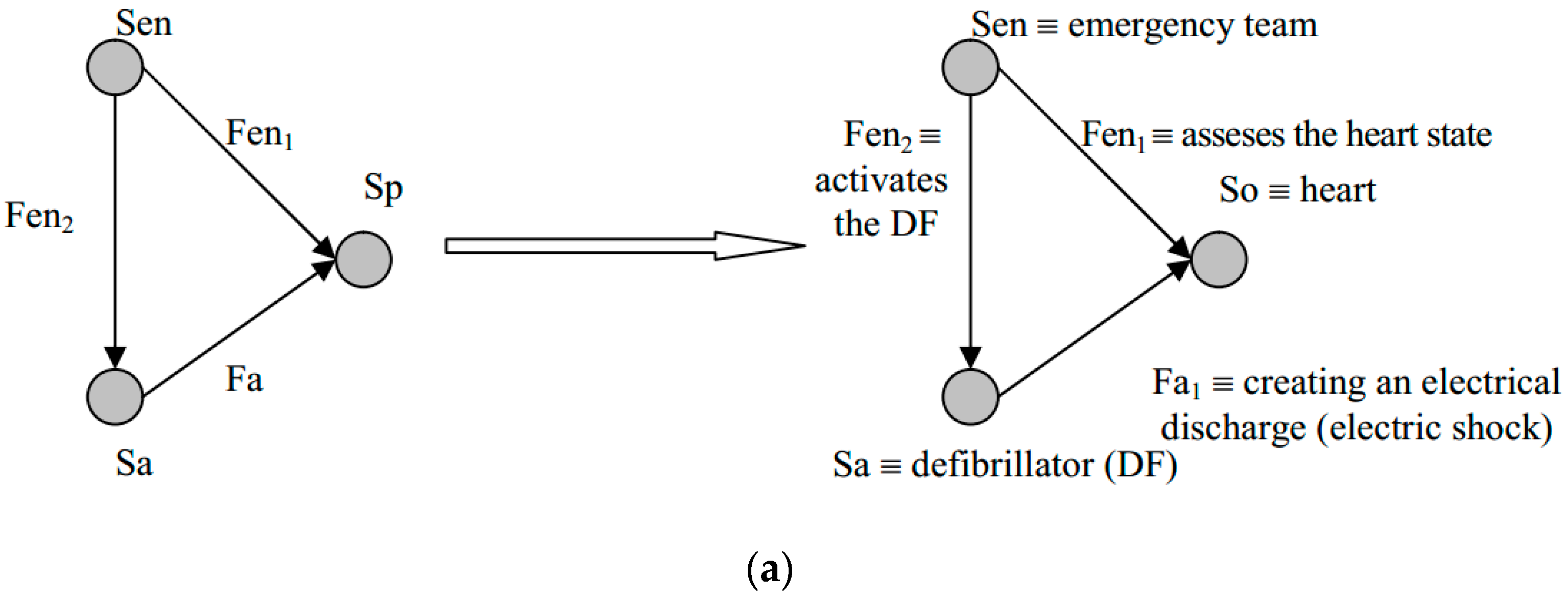
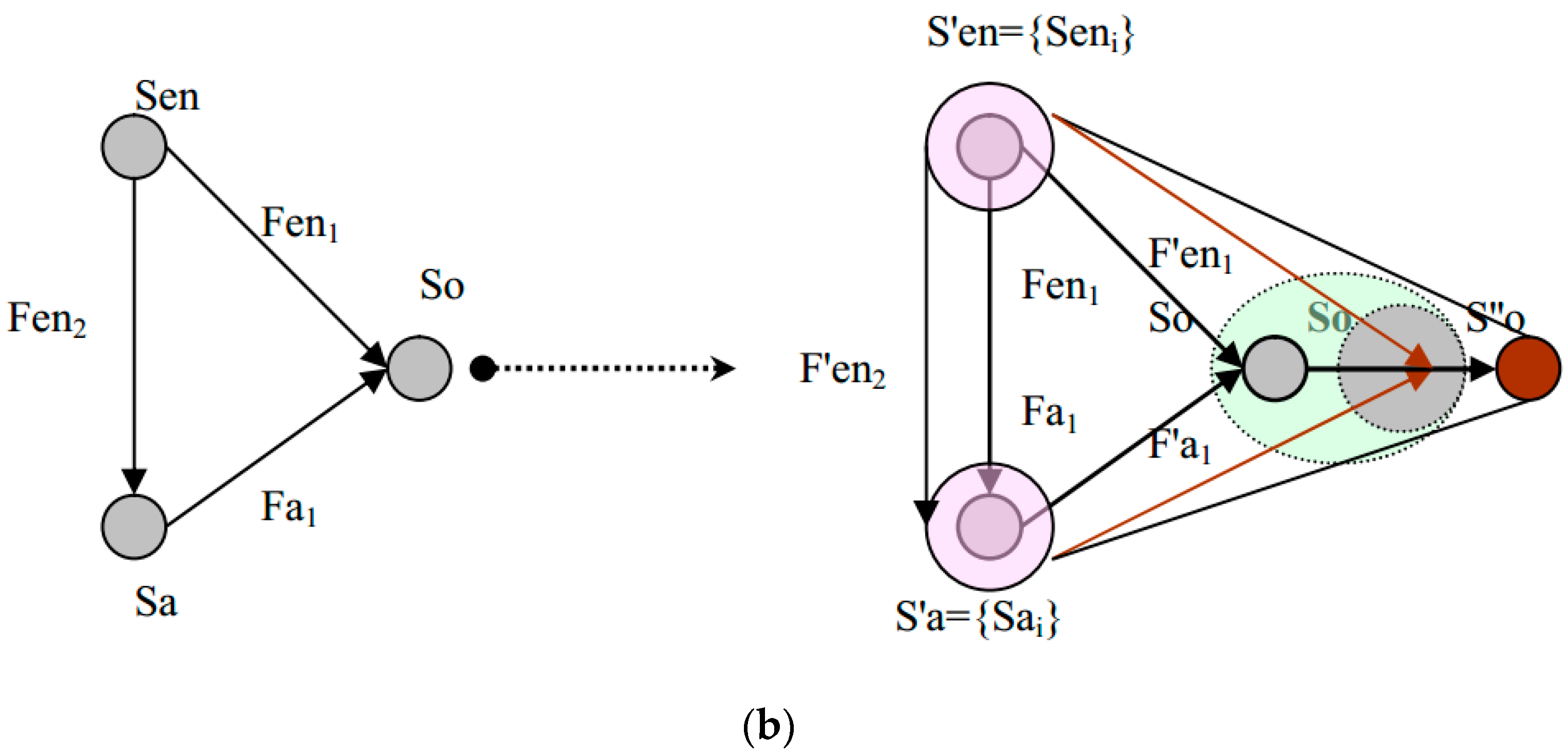

 indicates PhC nodes (1—regarding the requirements to Sen from the interactions between Sen and Sa; 2—regarding the requirements to Sen from the interactions between Sen and S0; 3—regarding the requirements to Sen from the interactions between Sen and Sa and between Sen and S0; 4—regarding the requirements to Sa from the interactions between Sen and Sa; 5—regarding the requirements to Sa from the interactions between Sa and S0 and between Sen and Sa; 6—regarding the requirements to Sen from the interactions between Sa and S0; 7—regarding the requirements to S0 from the interactions between Sa and S0 and between Sen and S0; 8, 9—regarding the requirements to S0 from the interactions between Sa and S0 and between Sen and S0). (Developed by the authors).
indicates PhC nodes (1—regarding the requirements to Sen from the interactions between Sen and Sa; 2—regarding the requirements to Sen from the interactions between Sen and S0; 3—regarding the requirements to Sen from the interactions between Sen and Sa and between Sen and S0; 4—regarding the requirements to Sa from the interactions between Sen and Sa; 5—regarding the requirements to Sa from the interactions between Sa and S0 and between Sen and Sa; 6—regarding the requirements to Sen from the interactions between Sa and S0; 7—regarding the requirements to S0 from the interactions between Sa and S0 and between Sen and S0; 8, 9—regarding the requirements to S0 from the interactions between Sa and S0 and between Sen and S0). (Developed by the authors).
 indicates PhC nodes (1—regarding the requirements to Sen from the interactions between Sen and Sa; 2—regarding the requirements to Sen from the interactions between Sen and S0; 3—regarding the requirements to Sen from the interactions between Sen and Sa and between Sen and S0; 4—regarding the requirements to Sa from the interactions between Sen and Sa; 5—regarding the requirements to Sa from the interactions between Sa and S0 and between Sen and Sa; 6—regarding the requirements to Sen from the interactions between Sa and S0; 7—regarding the requirements to S0 from the interactions between Sa and S0 and between Sen and S0; 8, 9—regarding the requirements to S0 from the interactions between Sa and S0 and between Sen and S0). (Developed by the authors).
indicates PhC nodes (1—regarding the requirements to Sen from the interactions between Sen and Sa; 2—regarding the requirements to Sen from the interactions between Sen and S0; 3—regarding the requirements to Sen from the interactions between Sen and Sa and between Sen and S0; 4—regarding the requirements to Sa from the interactions between Sen and Sa; 5—regarding the requirements to Sa from the interactions between Sa and S0 and between Sen and Sa; 6—regarding the requirements to Sen from the interactions between Sa and S0; 7—regarding the requirements to S0 from the interactions between Sa and S0 and between Sen and S0; 8, 9—regarding the requirements to S0 from the interactions between Sa and S0 and between Sen and S0). (Developed by the authors).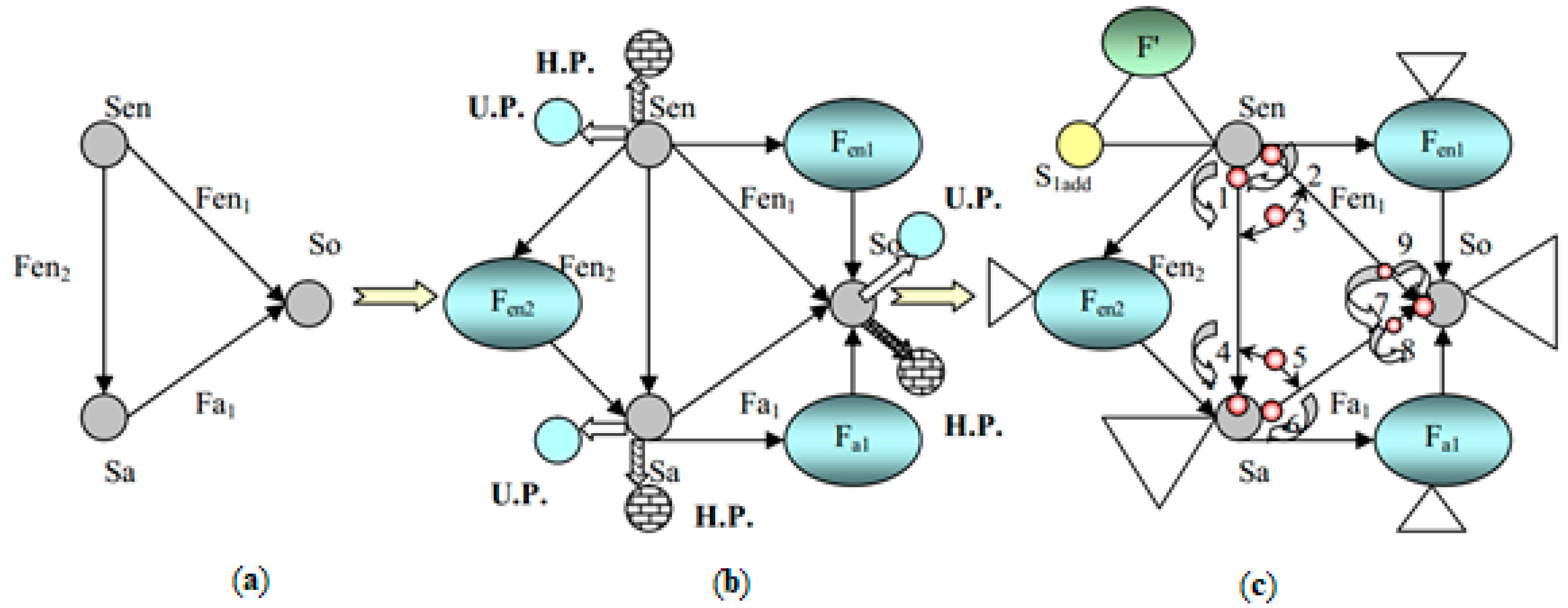
 are PhC nodes: (a) common triad model; (b) expanded triad model with indicated TOP and SF models within it; (c) expanded triad model with highlighted PhC model clusters (dotted circles) and the SFs (dotted triangles) (developed by authors).
are PhC nodes: (a) common triad model; (b) expanded triad model with indicated TOP and SF models within it; (c) expanded triad model with highlighted PhC model clusters (dotted circles) and the SFs (dotted triangles) (developed by authors).
 are PhC nodes: (a) common triad model; (b) expanded triad model with indicated TOP and SF models within it; (c) expanded triad model with highlighted PhC model clusters (dotted circles) and the SFs (dotted triangles) (developed by authors).
are PhC nodes: (a) common triad model; (b) expanded triad model with indicated TOP and SF models within it; (c) expanded triad model with highlighted PhC model clusters (dotted circles) and the SFs (dotted triangles) (developed by authors).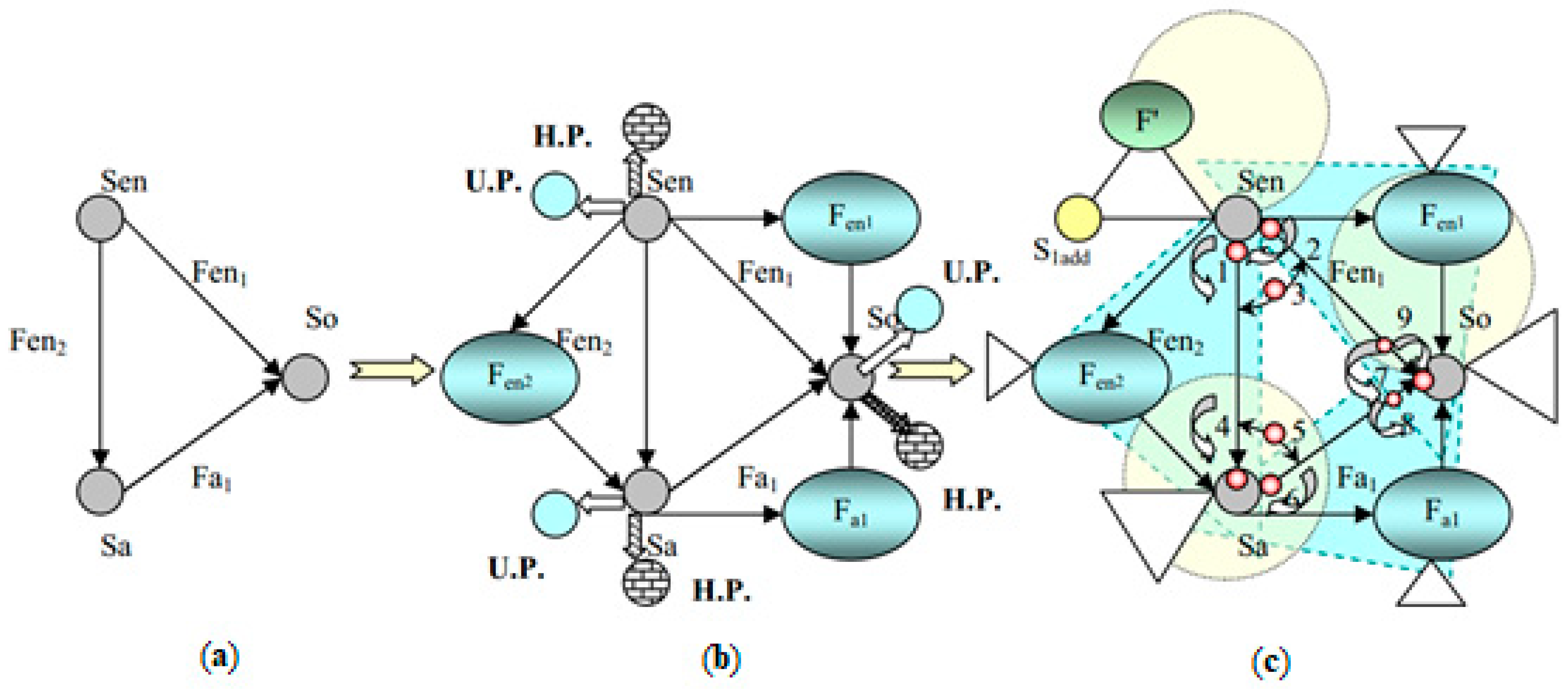
 are PhC nodes: (a) generator produces the low energy pulse; (b) generator produces a strictly defined high-energy pulse.
are PhC nodes: (a) generator produces the low energy pulse; (b) generator produces a strictly defined high-energy pulse.
 are PhC nodes: (a) generator produces the low energy pulse; (b) generator produces a strictly defined high-energy pulse.
are PhC nodes: (a) generator produces the low energy pulse; (b) generator produces a strictly defined high-energy pulse.
| Model Name, Source | Model Features | |||
|---|---|---|---|---|
| Modelling Object | Number of Elements | Application | Presentation Form | |
| Substance-field (S-F) [26,27,28] | Problem function | Minimum 3 | Solving tasks of TS modernisation and structural synthesis, forecasting TS development | Graphic |
| Physical contradiction (PhC) [27,28] | Problem element, conflicting functions | 3 | Solving tasks of TS modernisation and structural synthesis | Verbal |
| FA (Functional Analysis) diagram (FAD) [29] | Internal function tree of the object under study, which shows types, relevancies and costs of functions and existing conflicts | Number of nodes and edges of the system function tree (TFG) | Identifying conflict problems Solving problems of TS modernisation and structural synthesis; facilitating selection of tools for solving identified problems | Graphic |
| “Nested” Function Model [30] | Tree of external and internal functions of the object under study | Number of nodes and edges of the TFG with external functions | Setting and solving tasks of TS modernisation and structural synthesis | Graphic |
| Multi Screen Model [31] | Past, current, and future system states, its super system and subsystems, changes in functionality and existing conflicts to their functions | 9 + number of changes + number of possible impacts on functionality + number of affected contradictions | Setting and solving tasks of TS modernisation and structural synthesis, forecasting TS development | Graphic (9S model), Table (Changes in Functionality and contra-dictions) |
| Extended “Nested” Function Model [30] | Tree of external and internal functions of object under study at different system levels and time states | Number of function tree nodes and edges at different system levels for 3 time states | Setting and solving tasks of TS modernisation and structural synthesis, forecasting TS development according to TS evolution laws and trends | Graphic, Verbal (trends of evolution) |
| CLD (Casual loop Diagram) model [32] | State and dynamics of causal relationships between system elements, system and super system, their interactions, and quality parameters | Number of nodes and edges of CLD system | Studying function characteristics within TFG, their relation to system quality parameters; possibility to estimate impact on parameters of every change in function structure and function characteristics. Identifying problem functions | Graphic |
| TOP model [33,34] | Changing state of function object under tool action | 4 | Setting and solving tasks of TS modernization and structural synthesis, forecasting TS development | Graphic |
| Triad model [35,36] | Main actors of useful activity and mutual functional links | 6 | Setting and solving tasks of TS modernisation and structural synthesis, forecasting TS development | Graphic |
| Action Character | Graphic Notation (Symbol Action) |
|---|---|
| Desired effect (useful) |  |
| Insufficient effect |  |
| Excessive useful effect |  |
| Harmful effect |  |
| Lacking desired useful effect |  |
| Missing action |  |
| Break of connection |  |
| Transformation |  |
| Results in |  |
| Poorly controlled |  |
Publisher’s Note: MDPI stays neutral with regard to jurisdictional claims in published maps and institutional affiliations. |
© 2022 by the authors. Licensee MDPI, Basel, Switzerland. This article is an open access article distributed under the terms and conditions of the Creative Commons Attribution (CC BY) license (https://creativecommons.org/licenses/by/4.0/).
Share and Cite
Kernytskyy, I.; Hlinenko, L.; Yakovenko, Y.; Horbay, O.; Koda, E.; Rusakov, K.; Yankiv, V.; Humenuyk, R.; Polyansky, P.; Berezovetskyi, S.; et al. Problem-Oriented Modelling for Biomedical Engineering Systems. Appl. Sci. 2022, 12, 7466. https://doi.org/10.3390/app12157466
Kernytskyy I, Hlinenko L, Yakovenko Y, Horbay O, Koda E, Rusakov K, Yankiv V, Humenuyk R, Polyansky P, Berezovetskyi S, et al. Problem-Oriented Modelling for Biomedical Engineering Systems. Applied Sciences. 2022; 12(15):7466. https://doi.org/10.3390/app12157466
Chicago/Turabian StyleKernytskyy, Ivan, Larysa Hlinenko, Yevheniia Yakovenko, Orest Horbay, Eugeniusz Koda, Konstantin Rusakov, Volodymyr Yankiv, Ruslan Humenuyk, Pavlo Polyansky, Serhii Berezovetskyi, and et al. 2022. "Problem-Oriented Modelling for Biomedical Engineering Systems" Applied Sciences 12, no. 15: 7466. https://doi.org/10.3390/app12157466






